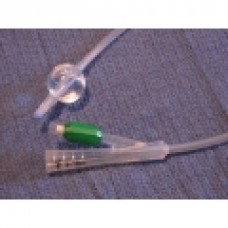FOLEY CATHETER, SILICON, 2-WAY, 40CM ,14FR 5-10ML, EACH (UR011001)
- Brand: Multigate Devices
- Product Code: UR011001
-
Ex GST: AU$6.62
FOLEY CATHETER 100% SILICONE 14Fr 40CM STERILE 10ml Balloon
Features
Size No: 14FR,
Balloon Size 5-10ml
ISO Standard Colour Codes
Color-coded instant identification of catheter size
100% Medical Grade Silicone.
Disposable Single Patient Use.
Smooth tapered tip of catheter facilitates easy introducing to the urethra.
The drainage eyes are accurately formed to permit affective drainage.
The symmetrical balloon expands equally in all directions so as to
perform its function of retaining bladder efficiently.
Valve accepts Luer Lock or Luer Slip.
Sterile Individually Double Wrapped.
TGA Registered Aust-L 142283.
General Information
A Foley catheter is a flexible tube that is often passed through the urethra and into the bladder. It is the most common type of indwelling urinary catheter.
The tube of a Foley catheter has two separated channels, or lumens, running down its length. One lumen is open at both ends, and allows urine to drain out into a collection bag. The other lumen has a valve on the outside end and connects to a balloon at the tip; the balloon is inflated with sterile water when it lies inside the bladder, in order to stop it from slipping out. Foley catheters are commonly made from silicone rubber or natural rubber.
Foley catheters should only be used when indicated, as using it increases the risk of catheter-associated urinary tract infection and other adverse effects.
Medical uses
In the urinary tract In an emergency department, indwelling urinary catheters are most commonly used to assist persons who cannot urinate. Indications for using a catheter include providing relief when there is urinary retention, monitoring urine output for critically ill persons, managing urination during surgery, and providing end-of-life care.
Foley catheters are used during the following situations:
On patients who are anesthesized or sedated for surgery or other medical care
On comatose patients
On some incontinent patients
On patients whose prostate is enlarged to the point that urine flow from the bladder is cut off. The catheter is kept in until the problem is resolved.
On patients with acute urinary retention.
On patients who are unable due to paralysis or physical injury to use either standard toilet facilities or urinals.
Following urethral surgeries
Following ureterectomy
On patients with kidney disease whose urine output must be constantly and accurately measured
Before and after cesarean sections
Before and after hysterectomies
On patients who had genital injury
A Foley catheter can also be used to ripen the cervix during induction of labor. When used for this purpose, the procedure is called extra-amniotic saline infusion (EASI). In this procedure, the balloon is inserted behind the cervical wall and inflated, such for example with 30 mL per hour. The remaining length of the catheter is pulled slightly taut, and taped to the inside of the woman's leg. The inflated balloon applies pressure to the cervix, as the baby's head would prior to labour, causing it to dilate. As the cervix dilates over time, the catheter is readjusted to again be slightly taut, and re-taped to maintain pressure on the cervix. When the cervix has dilated sufficiently, the catheter simply drops out.
Contraindications
Indwelling urinary catheters should not be used in emergency departments to monitor stable people who are able to urinate or for the convenience of the patient or hospital staff.
Adverse effects
A major problem with Foley catheters is that they have a tendency to contribute to urinary tract infections (UTI). This occurs because bacteria can travel up the catheters to the bladder where the urine can become infected. To combat this, the industry is moving to antiseptic coated catheters. This has been helpful, but it has not completely solved this major problem. An additional problem is that Foley catheters tend to become coated over time with a biofilm that can obstruct the drainage. This increases the amount of stagnant urine left in the bladder, which further contributes to the problem of urinary tract infections. When a Foley catheter becomes clogged, it must be flushed or replaced.
Tags: Urology, Incontinence, Indwelling Catheterization, Aseptic Techniques

